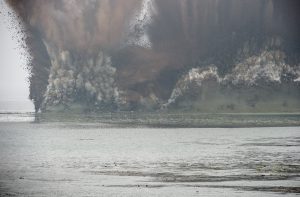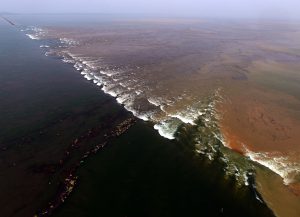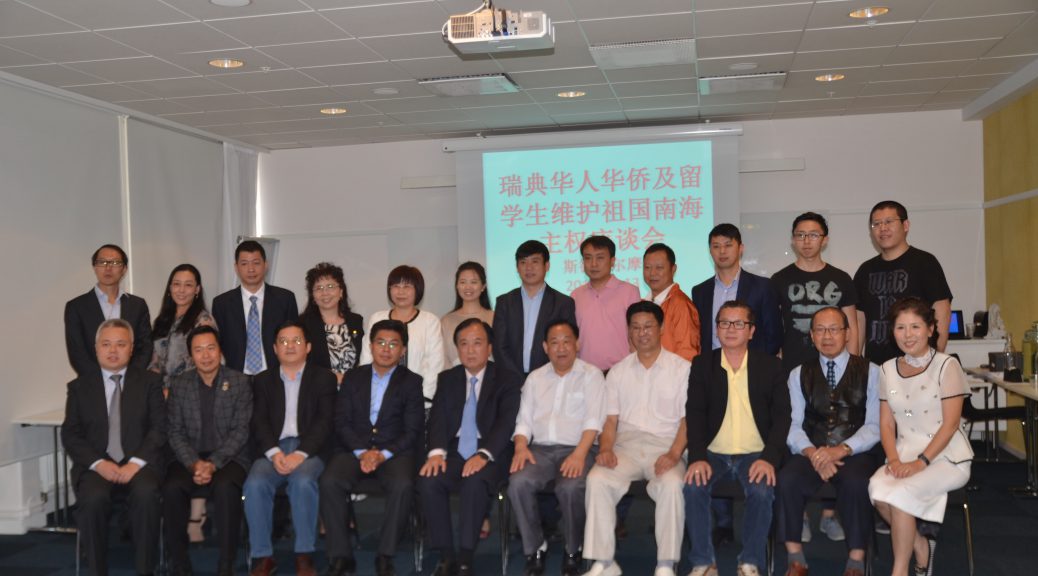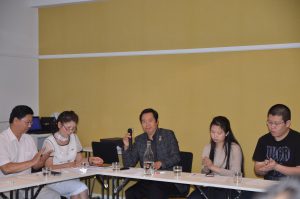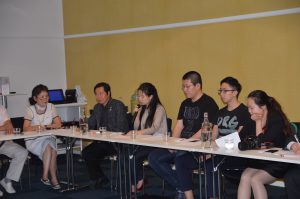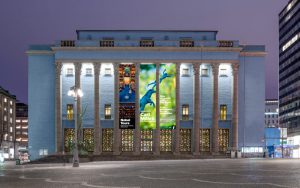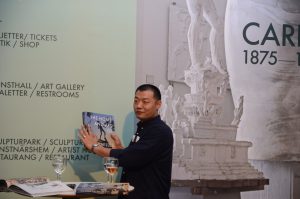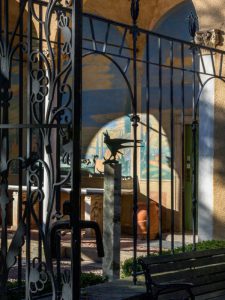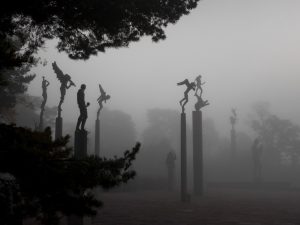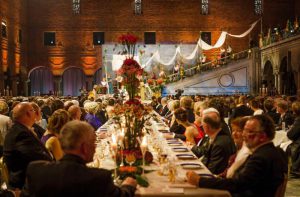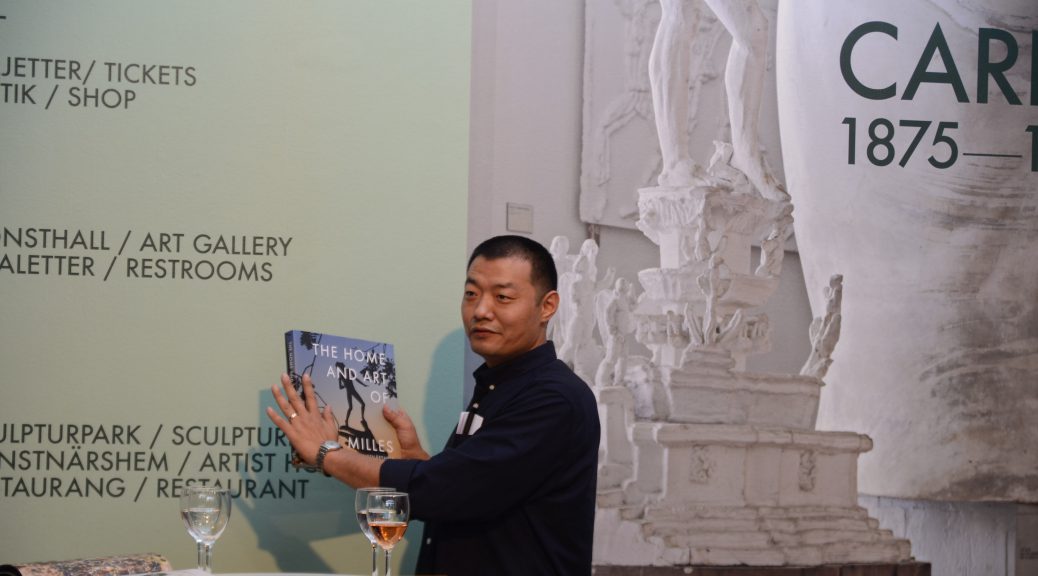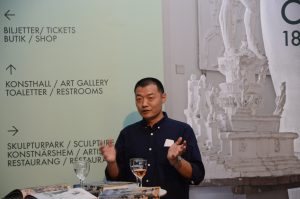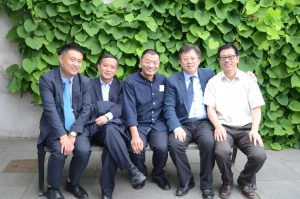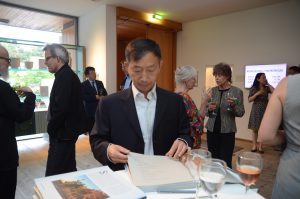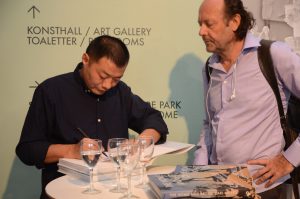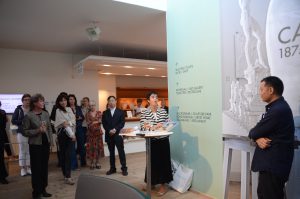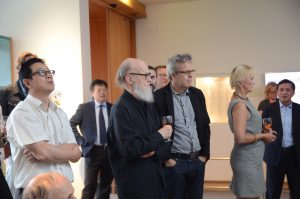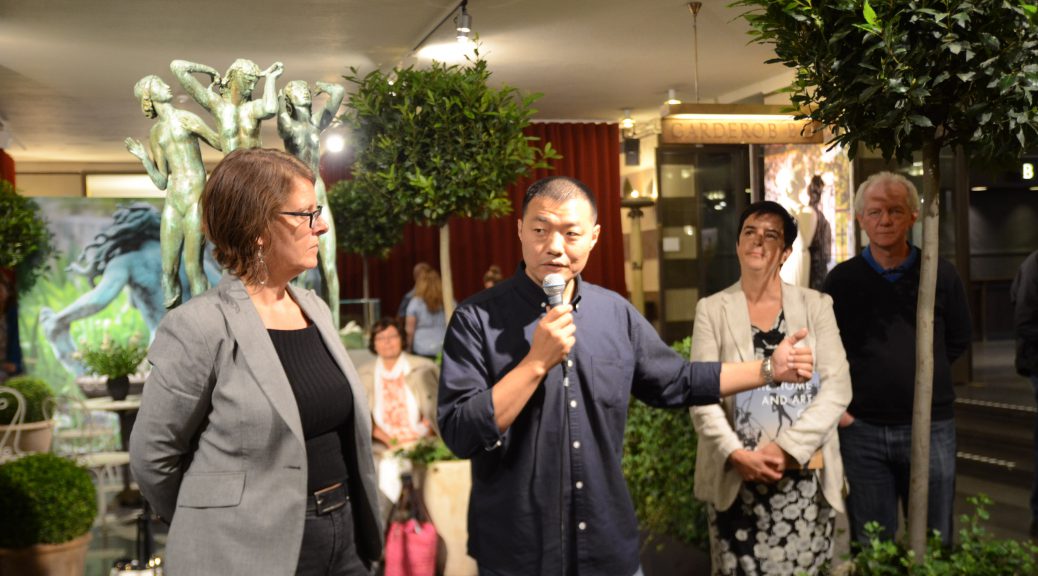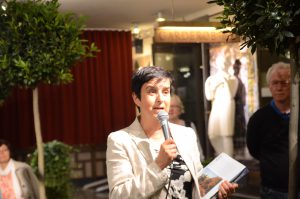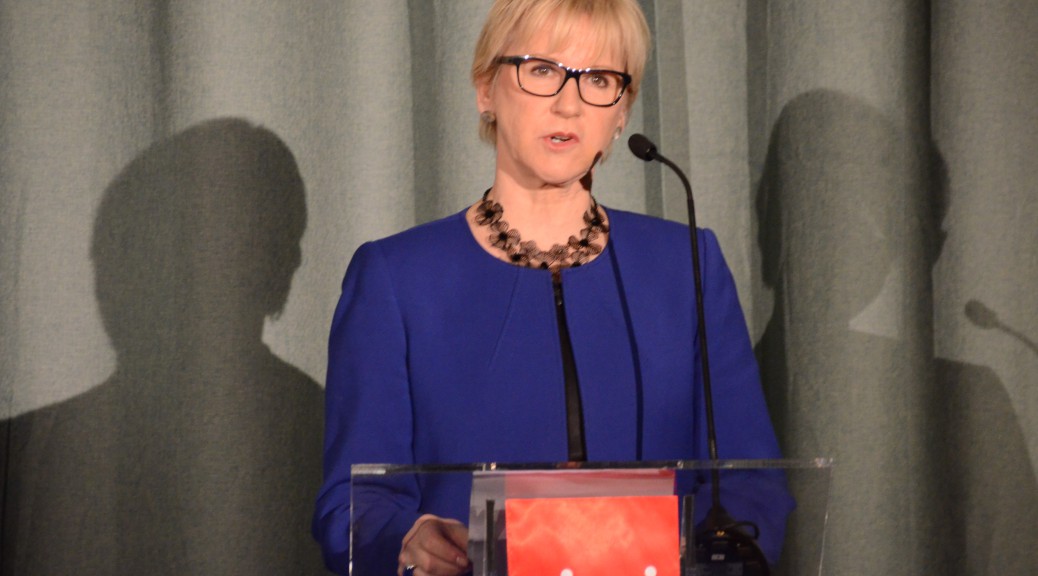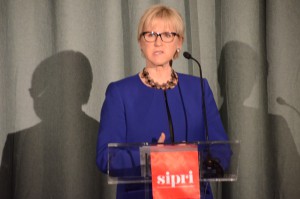Category Archives: News
湖北省两湖相并改善水质防止洪涝
今日头条:瑞典华人华侨及留学生发表联合声明坚决支持中国政府对南海仲裁案的立场
北欧绿色邮报网报道(记者陈雪霏)——7月13日下午,由瑞典中国和平统一促进会主办,瑞典各华人社团、留学生代表,华文媒体代表在首都斯德哥尔摩举行座谈会,就海牙国际仲裁法院12日关于南海仲裁案的裁决发表联合声明。声明全文如下:
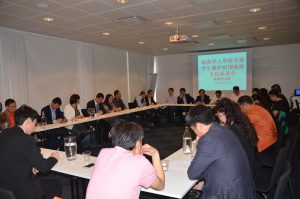 一、瑞典华人华侨、留学生支持中国政府不承认、不接受、不执行、不参与 菲律宾提起仲裁决定。
一、瑞典华人华侨、留学生支持中国政府不承认、不接受、不执行、不参与 菲律宾提起仲裁决定。
二、南海仲裁案完全是菲律宾强加给中国的,它建立在菲律宾一系列违法行 为和非法诉求基础之上。背后隐藏着不良政治 图谋,即有人有意挑事,刻意激 化矛盾,怂恿对抗,唯恐南海不乱。仲裁庭没有管辖权,其自行扩权、越权审理 并做出裁决,违背了《联合国海洋法公约》,是非 法的、无效的。中国不参与、 不接受这样的仲裁,不承认所谓的裁决
三、在南海问题上中国绝不是加害者、肇事者,而是完完全全的受害者。根 据国际法,中国完全享有自保权和自卫权,有能力收复上述岛礁。但从维护地区 和平稳定的角度出发, 中国长期以来一直保持高度克制,寻求通过谈判和平解 决。近年来中国采取的一些行动,只是在忍无可忍的情况下针对个别国家侵权行 动升级的最低限度的响应。
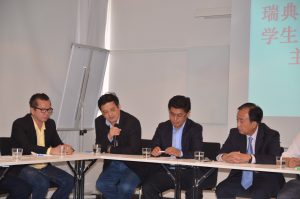 四、在领土问题和海域划界争议上,中国不接受任何第三方争端解决方式, 不接受任何强加于中国的争端解决方案。中国政府将继续遵循《联合国宪章》确 认的国际法和国际关系基本准则,坚持与直接有关当事国在尊重历史事实的基础 上,根据国际法,通过谈判协商解决南海有关争议,维护南海和平稳定。
四、在领土问题和海域划界争议上,中国不接受任何第三方争端解决方式, 不接受任何强加于中国的争端解决方案。中国政府将继续遵循《联合国宪章》确 认的国际法和国际关系基本准则,坚持与直接有关当事国在尊重历史事实的基础 上,根据国际法,通过谈判协商解决南海有关争议,维护南海和平稳定。
出席座谈会的有中国驻瑞典大使陈育明,领事部主任郭延航,瑞典中国和平统一促进会会长叶克清,瑞典华人总会执行主席叶沛群,秘书长唐兵,王钰清,瑞典华人联合会名誉主席王吉生,瑞典华人工商联常务副会长夏海龙,瑞典广东同乡会代表梁振德,人民网记者李玫忆,北欧华人网的宗金波,瑞典留学生代表熊梓懿,瑞典华文学校代表王梅霜和潮州同乡会会长陈德忠。
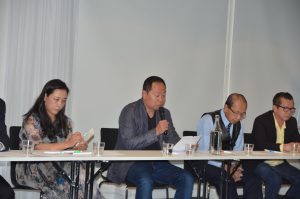 代表们在座谈会上纷纷表示积极支持中国政府在南海问题上的立场,同时号召海峡两岸中国人应该团结起来一起维护中华民族的共同权益。
代表们在座谈会上纷纷表示积极支持中国政府在南海问题上的立场,同时号召海峡两岸中国人应该团结起来一起维护中华民族的共同权益。
 瑞典中国和平统一促进会会长叶克清说:南海仲裁案不过是一场披着法律外衣的闹剧,实际上是美国在搅乱南海,遏制中国和平发展的险恶用心。天下人包括菲律宾、美国在内的所有人都很清楚,南海仲裁案“既不合理也不合法”,解决不了南海问题,仲裁庭一意孤行接受菲律宾单方面诉求,丝毫没有顾及《南海各方行为宣言》等已经建立的国际法规则,丝毫没有顾及正在发挥作用的对话机制、平台与框架。仲裁庭把《联合国海洋法公约》强制凌驾于受国际法保护的和平对话框架之上,构成了对国际法的伤害和对地区和平对话机制的损害,这是扩权和滥权。并且,仲裁庭的扩权和滥权还侵犯了《公约》缔约国所享有的权利。从仲裁的后果看,其丝毫无助于维护南海的和平稳定。
瑞典中国和平统一促进会会长叶克清说:南海仲裁案不过是一场披着法律外衣的闹剧,实际上是美国在搅乱南海,遏制中国和平发展的险恶用心。天下人包括菲律宾、美国在内的所有人都很清楚,南海仲裁案“既不合理也不合法”,解决不了南海问题,仲裁庭一意孤行接受菲律宾单方面诉求,丝毫没有顾及《南海各方行为宣言》等已经建立的国际法规则,丝毫没有顾及正在发挥作用的对话机制、平台与框架。仲裁庭把《联合国海洋法公约》强制凌驾于受国际法保护的和平对话框架之上,构成了对国际法的伤害和对地区和平对话机制的损害,这是扩权和滥权。并且,仲裁庭的扩权和滥权还侵犯了《公约》缔约国所享有的权利。从仲裁的后果看,其丝毫无助于维护南海的和平稳定。
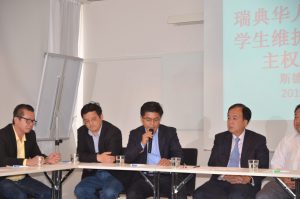 瑞典华人总会执行主席叶沛群说:这种仲裁闹剧使两岸不约而同地坚决反对,共同维护南海主权的一致行动,将能更好地维护中华民族的共同利益,有助于促进两岸关系向前发展。只要祖国继续快速发展和安定,只要祖国更强大,类似的闹剧就不会发生了。
瑞典华人总会执行主席叶沛群说:这种仲裁闹剧使两岸不约而同地坚决反对,共同维护南海主权的一致行动,将能更好地维护中华民族的共同利益,有助于促进两岸关系向前发展。只要祖国继续快速发展和安定,只要祖国更强大,类似的闹剧就不会发生了。
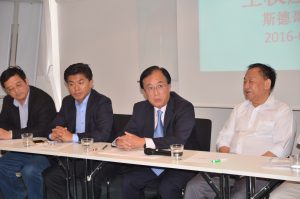 中国驻瑞典大使陈育明听完华人华侨和留学生代表的发言后说,他为华人华侨捍卫国家主权积极支持中国政府的心声深为感动。
中国驻瑞典大使陈育明听完华人华侨和留学生代表的发言后说,他为华人华侨捍卫国家主权积极支持中国政府的心声深为感动。
他说:大家的心声充分显示了炎黄子孙心连心,肩并肩直面挑战的坚强意志。
陈大使说,中国在南海的领土主权不可否定,中国是最早給南海诸岛命名并实施有效管辖的。
中国不接受南海仲裁案闹剧是对国际法制和地区规则的权威性和严肃性的尊重。领土主权问题超出了联合国海洋法公约的调整范围。联合国海洋法公约的宗旨是在顾及国家主权的情况下对海洋建立的国际秩序。而国际仲裁廷超越了联合国海洋法公约的调整范围。
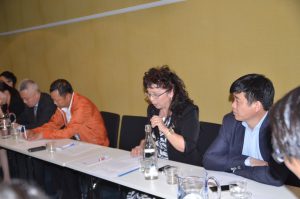 中国愿意通过谈判来解决边界争端。已经与12个邻国签订了边界条约。
中国愿意通过谈判来解决边界争端。已经与12个邻国签订了边界条约。
陈大使说他希望华人华侨通过朋友同事解释中国的立场和观点。
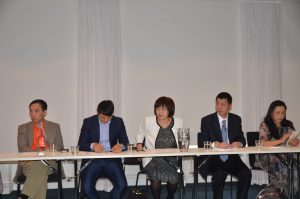 出席座谈会的还有瑞典中国和平统一促进会的周斌,伍王令,华人工商联副会长的黄炳旺,理事曹海嘉,华人联合会的郭彦彩,中欧文化协会会长陈雪霏,青田同乡会的周民伟,瑞中企业家协会会长张巧珍,两湖同乡会副会长吕长琳。
出席座谈会的还有瑞典中国和平统一促进会的周斌,伍王令,华人工商联副会长的黄炳旺,理事曹海嘉,华人联合会的郭彦彩,中欧文化协会会长陈雪霏,青田同乡会的周民伟,瑞中企业家协会会长张巧珍,两湖同乡会副会长吕长琳。
北欧之春剧组聚会演唱录音剪辑
Top story: China rejects the ruling of the Arbitral Tribunal in the South China Sea Arbitration
STOCKHOLM, July 12(Greenpost)–Chinese Ministry of Foreign Affairs has rejected the Arbitral Tribunal’s ruling on the South China Sea on July 12, 2016.
The following is the full text translation of Statement of the Ministry of Foreign Affairs of the People’s Republic of China on the Award of 12 July 2016 of the Arbitral Tribunal in the South China Sea Arbitration Established at the Request of the Republic of the Philippines
With regard to the award rendered on 12 July 2016 by the Arbitral Tribunal in the South China Sea arbitration established at the unilateral request of the Republic of the Philippines (hereinafter referred to as the “Arbitral Tribunal”), the Ministry of Foreign Affairs of the People’s Republic of China solemnly declares that the award is null and void and has no binding force. China neither accepts nor recognizes it.
1. On 22 January 2013, the then government of the Republic of the Philippines unilaterally initiated arbitration on the relevant disputes in the South China Sea between China and the Philippines. On 19 February 2013, the Chinese government solemnly declared that it neither accepts nor participates in that arbitration and has since repeatedly reiterated that position. On 7 December 2014, the Chinese government released the Position Paper of the Government of the People’s Republic of China on the Matter of Jurisdiction in the South China Sea Arbitration Initiated by the Republic of the Philippines, pointing out that the Philippines’ initiation of arbitration breaches the agreement between the two states, violates the United Nations Convention on the Law of the Sea (UNCLOS), and goes against the general practice of international arbitration, and that the Arbitral Tribunal has no jurisdiction. On 29 October 2015, the Arbitral Tribunal rendered an award on jurisdiction and admissibility. The Chinese government immediately stated that the award is null and void and has no binding force. China’s positions are clear and consistent.
2. The unilateral initiation of arbitration by the Philippines is out of bad faith. It aims not to resolve the relevant disputes between China and the Philippines, or to maintain peace and stability in the South China Sea, but to deny China’s territorial sovereignty and maritime rights and interests in the South China Sea. The initiation of this arbitration violates international law. First, the subject-matter of the arbitration initiated by the Philippines is in essence an issue of territorial sovereignty over some islands and reefs of Nansha Qundao (the Nansha Islands), and inevitably concerns and cannot be separated from maritime delimitation between China and the Philippines. Fully aware that territorial issues are not subject to UNCLOS, and that maritime delimitation disputes have been excluded from the UNCLOS compulsory dispute settlement procedures by China’s 2006 declaration, the Philippines deliberately packaged the relevant disputes as mere issues concerning the interpretation or application of UNCLOS. Second, the Philippines’ unilateral initiation of arbitration infringes upon China’s right as a state party to UNCLOS to choose on its own will the procedures and means for dispute settlement. As early as in 2006, pursuant to Article 298 of UNCLOS, China excluded from the compulsory dispute settlement procedures of UNCLOS disputes concerning, among others, maritime delimitation, historic bays or titles, military and law enforcement activities. Third, the Philippines’ unilateral initiation of arbitration violates the bilateral agreement reached between China and the Philippines, and repeatedly reaffirmed over the years, to resolve relevant disputes in the South China Sea through negotiations. Fourth, the Philippines’ unilateral initiation of arbitration violates the commitment made by China and ASEAN Member States, including the Philippines, in the 2002 Declaration on the Conduct of Parties in the South China Sea (DOC) to resolve the relevant disputes through negotiations by states directly concerned. By unilaterally initiating the arbitration, the Philippines violates UNCLOS and its provisions on the application of dispute settlement procedures, the principle of “pacta sunt servanda” and other rules and principles of international law.
3. The Arbitral Tribunal disregards the fact that the essence of the subject-matter of the arbitration initiated by the Philippines is issues of territorial sovereignty and maritime delimitation, erroneously interprets the common choice of means of dispute settlement already made jointly by China and the Philippines, erroneously construes the legal effect of the relevant commitment in the DOC, deliberately circumvents the optional exceptions declaration made by China under Article 298 of UNCLOS, selectively takes relevant islands and reefs out of the macro-geographical framework of Nanhai Zhudao (the South China Sea Islands), subjectively and speculatively interprets and applies UNCLOS, and obviously errs in ascertaining facts and applying the law. The conduct of the Arbitral Tribunal and its awards seriously contravene the general practice of international arbitration, completely deviate from the object and purpose of UNCLOS to promote peaceful settlement of disputes, substantially impair the integrity and authority of UNCLOS, gravely infringe upon China’s legitimate rights as a sovereign state and state party to UNCLOS, and are unjust and unlawful.
4. China’s territorial sovereignty and maritime rights and interests in the South China Sea shall under no circumstances be affected by those awards. China opposes and will never accept any claim or action based on those awards.
5. The Chinese government reiterates that, regarding territorial issues and maritime delimitation disputes, China does not accept any means of third party dispute settlement or any solution imposed on China. The Chinese government will continue to abide by international law and basic norms governing international relations as enshrined in the Charter of the United Nations, including the principles of respecting state sovereignty and territorial integrity and peaceful settlement of disputes, and continue to work with states directly concerned to resolve the relevant disputes in the South China Sea through negotiations and consultations on the basis of respecting historical facts and in accordance with international law, so as to maintain peace and stability in the South China Sea.
Source: Foreign Affairs Ministry of People’s Republic of China.
Top story: China’s stance on its Territorial Sovereignty and Maritime Rights and interests in the South China Sea
STOCKHOLM, July 12, (Greenpost)- Chinese government has issued a statement on its stance on the South China Sea.
The following is the full text of the statement:
Statement of the Government of the People’s Republic of China on China’s Territorial Sovereignty and Maritime Rights and Interests in the South China Sea
To reaffirm China’s territorial sovereignty and maritime rights and interests in the South China Sea, enhance cooperation in the South China Sea with other countries, and uphold peace and stability in the South China Sea, the Government of the People’s Republic of China hereby states as follows:
I. China’s Nanhai Zhudao (the South China Sea Islands) consist of Dongsha Qundao (the Dongsha Islands), Xisha Qundao (the Xisha Islands), Zhongsha Qundao (the Zhongsha Islands) and Nansha Qundao (the Nansha Islands). The activities of the Chinese people in the South China Sea date back to over 2,000 years ago. China is the first to have discovered, named, and explored and exploited Nanhai Zhudao and relevant waters, and the first to have exercised sovereignty and jurisdiction over them continuously, peacefully and effectively, thus establishing territorial sovereignty and relevant rights and interests in the South China Sea.
Following the end of the Second World War, China recovered and resumed the exercise of sovereignty over Nanhai Zhudao which had been illegally occupied by Japan during its war of aggression against China. To strengthen the administration over Nanhai Zhudao, the Chinese government in 1947 reviewed and updated the geographical names of Nanhai Zhudao, compiled Nan Hai Zhu Dao Di Li Zhi Lüe (A Brief Account of the Geography of the South China Sea Islands), and drew Nan Hai Zhu Dao Wei Zhi Tu (Location Map of the South China Sea Islands) on which the dotted line is marked. This map was officially published and made known to the world by the Chinese government in February 1948.
II. Since its founding on 1 October 1949, the People’s Republic of China has been firm in upholding China’s territorial sovereignty and maritime rights and interests in the South China Sea. A series of legal instruments, such as the 1958 Declaration of the Government of the People’s Republic of China on China’s Territorial Sea, the 1992 Law of the People’s Republic of China on the Territorial Sea and the Contiguous Zone, the 1998 Law of the People’s Republic of China on the Exclusive Economic Zone and the Continental Shelf and the 1996 Decision of the Standing Committee of the National People’s Congress of the People’s Republic of China on the Ratification of the United Nations Convention on the Law of the Sea, have further reaffirmed China’s territorial sovereignty and maritime rights and interests in the South China Sea.
III. Based on the practice of the Chinese people and the Chinese government in the long course of history and the position consistently upheld by successive Chinese governments, and in accordance with national law and international law, including the United Nations Convention on the Law of the Sea, China has territorial sovereignty and maritime rights and interests in the South China Sea, including, inter alia:
i. China has sovereignty over Nanhai Zhudao, consisting of Dongsha Qundao, Xisha Qundao, Zhongsha Qundao and Nansha Qundao;
ii. China has internal waters, territorial sea and contiguous zone, based on Nanhai Zhudao;
iii. China has exclusive economic zone and continental shelf, based on Nanhai Zhudao;
iv. China has historic rights in the South China Sea.
The above positions are consistent with relevant international law and practice.
IV. China is always firmly opposed to the invasion and illegal occupation by certain states of some islands and reefs of China’s Nansha Qundao, and activities infringing upon China’s rights and interests in relevant maritime areas under China’s jurisdiction. China stands ready to continue to resolve the relevant disputes peacefully through negotiation and consultation with the states directly concerned on the basis of respecting historical facts and in accordance with international law. Pending final settlement, China is also ready to make every effort with the states directly concerned to enter into provisional arrangements of a practical nature, including joint development in relevant maritime areas, in order to achieve win-win results and jointly maintain peace and stability in the South China Sea.
V. China respects and upholds the freedom of navigation and overflight enjoyed by all states under international law in the South China Sea, and stays ready to work with other coastal states and the international community to ensure the safety of and the unimpeded access to the international shipping lanes in the South China Sea.
头条要闻:中华人民共和国外交部关于应菲律宾共和国请求建立的南海仲裁案仲裁庭所作裁决的声明
北欧绿色邮报网7月12日特约授权发布:《中华人民共和国外交部关于应菲律宾共和国请求建立的南海仲裁》。全文如下:
关于应菲律宾共和国单方面请求建立的南海仲裁案仲裁庭(以下简称“仲裁庭”)于2016年7月12日作出的裁决,中华人民共和国外交部郑重声明,该裁决是无效的,没有拘束力,中国不接受、不承认。
一、2013年1月22日,菲律宾共和国时任政府单方面就中菲在南海的有关争议提起仲裁。2013年2月19日,中国政府郑重宣布不接受、不参与菲律宾提起的仲裁,此后多次重申此立场。2014年12月7日,中国政府发表《中华人民共和国政府关于菲律宾共和国所提南海仲裁案管辖权问题的立场文件》,指出菲律宾提起仲裁违背中菲协议,违背《联合国海洋法公约》(以下简称《公约》),违背国际仲裁一般实践,仲裁庭不具有管辖权。2015年10月29日,仲裁庭作出管辖权和可受理性问题的裁决。中国政府当即声明该裁决是无效的,没有拘束力。中国上述立场是明确的、一贯的。
二、菲律宾单方面提起仲裁,目的是恶意的,不是为了解决与中国的争议,也不是为了维护南海的和平与稳定,而是为了否定中国在南海的领土主权和海洋权益。菲律宾提起仲裁的行为违反国际法。一是菲律宾提起仲裁事项的实质是南沙群岛部分岛礁的领土主权问题,有关事项也必然涉及中菲海洋划界,与之不可分割。在明知领土问题不属于《公约》调整范围,海洋划界争议已被中国2006年有关声明排除的情况下,菲律宾将有关争议刻意包装成单纯的《公约》解释或适用问题。二是菲律宾单方面提起仲裁,侵犯中国作为《公约》缔约国享有的自主选择争端解决程序和方式的权利。中国早在2006年即根据《公约》第298条将涉及海洋划界、历史性海湾或所有权、军事和执法活动等方面的争端排除出《公约》强制争端解决程序。三是菲律宾单方面提起仲裁,违反中菲两国达成并多年来一再确认的通过谈判解决南海有关争议的双边协议。四是菲律宾单方面提起仲裁,违反中国与包括菲律宾在内的东盟国家在2002年《南海各方行为宣言》(以下简称《宣言》)中作出的由直接有关当事国通过谈判解决有关争议的承诺。菲律宾单方面提起仲裁,违反了《公约》及其适用争端解决程序的规定,违反了“约定必须遵守”原则,也违反了其他国际法原则和规则。
三、仲裁庭无视菲律宾提起仲裁事项的实质是领土主权和海洋划界问题,错误解读中菲对争端解决方式的共同选择,错误解读《宣言》中有关承诺的法律效力,恶意规避中国根据《公约》第298条作出的排除性声明,有选择性地把有关岛礁从南海诸岛的宏观地理背景中剥离出来并主观想象地解释和适用《公约》,在认定事实和适用法律上存在明显错误。仲裁庭的行为及其裁决严重背离国际仲裁一般实践,完全背离《公约》促进和平解决争端的目的及宗旨,严重损害《公约》的完整性和权威性,严重侵犯中国作为主权国家和《公约》缔约国的合法权利,是不公正和不合法的。
四、中国在南海的领土主权和海洋权益在任何情况下不受仲裁裁决的影响,中国反对且不接受任何基于该仲裁裁决的主张和行动。
五、中国政府重申,在领土问题和海洋划界争议上,中国不接受任何第三方争端解决方式,不接受任何强加于中国的争端解决方案。中国政府将继续遵循《联合国宪章》确认的国际法和国际关系基本准则,包括尊重国家主权和领土完整以及和平解决争端原则,坚持与直接有关当事国在尊重历史事实的基础上,根据国际法,通过谈判协商解决南海有关争议,维护南海和平稳定。
来源:中国驻瑞典大使馆网站
南海诸岛自古属于中国
北欧绿色邮报网社论 陈雪霏
南海诸岛自古属于中国,也依然属于中国。任何挑衅都改变不了这个事实。
独家专访:一个展览,一本书,一次东西方文化的碰撞PDF版
法国中北部遭洪水侵袭
独家专访: 一个展览,一本书,一次东西方文化的碰撞--著名华人摄影师李亚男“诺贝尔颁奖大厅”大展,暨新书发布
北欧绿色邮报网独家专访(记者陈雪霏)——2016年斯德哥尔摩音乐厅的夏天是属于华人的夏天。从6月28日开始,一直到8月20日,整个暑假,瑞典著名华人摄影师李亚男眼中的瑞典国宝级雕塑园《米勒斯花园的四季》在音乐艺术的殿堂,每年颁发诺贝尔奖的斯德哥尔摩音乐厅展出。这对于华人来说是一种骄傲。李亚男为什么要拍摄米勒斯花园?为什么他的摄影与众不同?这批照片为什么直抵如此圣殿?带着这些问题,本网记者在家中专访了李亚男。
斯德哥尔摩音乐厅诺贝尔颁奖殿堂前的米勒斯群雕塑。李亚男拍摄。
有《米勒斯花园的四季》展览巨幅海报的斯德哥尔摩音乐厅夜景。 李亚男拍摄
“能够在这里做夏展在瑞典艺术界是个很高的荣誉。就是整个音乐厅的两个夏展之一,一个就是它每年在全瑞典选一个艺术家的夏展,另一个是作为诺贝尔奖颁奖地的诺贝尔主题的常年展。”李亚男说。
提起李亚男,一连串头衔令人惊叹, 哈苏(相机)大使,瑞典皇后御用摄影师,曾经掌镜瑞典斯德哥尔摩市政厅,现任斯德哥尔摩省政府官方摄影师……数年前曾经以一本“ 未知之美-斯德哥尔摩市政厅” 囊括众多瑞典图书界,摄影界大奖。华盛顿,布鲁塞尔,斯德哥尔摩的许多极具重量级的地方都曾举办过他的个展。他曾经拍摄过瑞典国王,皇后,胡锦涛,习近平,温家宝,他为瑞典国宝级诗人,2011年诺贝尔文学奖获得者托马斯. 特朗斯特罗姆拍摄的肖像被选入瑞典今天中学教材的封面。在瑞典摄影界,一个中国人,手里拿着哈苏相机,成为瑞典炙手可热的几个顶级摄影师之一。
这个多年做为诺贝尔颁奖,诺贝尔晚宴指定摄影师的人,现在把自己的作品摆在了诺贝尔颁奖大厅了,而且,不是一两天,而是整个夏天。全瑞典人和世界各地的游客都可以欣赏到他的作品。
斯德哥尔摩音乐厅夏展每年秋季筛选,次年三月份同音乐厅年度规划同时盛大发布,今年夏展从6月28日开始到8月20日每天11:00-17:00对公众开放,人们可以尽情享受一个充满激情的华人摄影师以东西方文化碰撞的视角历时三年拍摄出来的米勒斯花园。预计有7万观众莅临。
左:音乐厅项目经理卡丽娜.斯万松,中:李亚男,右二:乌妮塔.瓦斯在《米勒斯花园的四季》夏展发布会上。2016-06-28 陈雪霏拍摄
“大概三年前吧,米勒斯花园的人找到我,他们说我们一直关注你的东西,你有没有兴趣拍米勒斯花园?他们给了我一把钥匙,一个单独的院子,可以随时住在米勒斯花园里。然后,整个米勒斯花园就是我的了。我就这样断断续续地,一但有时间,我就到米勒斯转一圈儿。然后,就拍了一大批东西。 这些东西流到了音乐厅。音乐厅就来找我,找米勒斯雕塑园,说希望办一个这样的大展。今年,瓜熟蒂落,一个展览,一本画册,同时推出。”李亚男介绍说。
6月30日新书《米勒斯的家园和艺术》在米勒斯花园发布,李亚男介绍新书发布的背景。 陈雪霏拍摄
这次展览总共有50多幅照片。同时发行的大型画册《米勒斯的家园和艺术》收集200多张照片。八年磨一剑,这是继2008年李亚男出版的摄影作品《未知之美 -斯德哥尔摩市政厅》之后的又一重磅作品。那本关于市政厅的书,至今仍然作为斯德哥尔摩市政厅的官方礼物。
《未知之美 斯德哥尔摩市政厅》 李亚男拍摄
李亚男曾在斯德哥尔摩市政厅作为官方摄影师工作了四年。后来,他又到省政府工作了。他现在也在为瑞典皇后做皇家摄影师。同时也在主持许多题材项目的拍摄。
“这是一本很重头的书, 书的序言是 由Cranbrook Art 博物馆馆长亲自主笔,全书近两百张照片,是近年来瑞典艺术界非常重头的出版物。
中国驻瑞典使馆文化参赞浦正东和米勒斯博物馆馆长乌妮塔.瓦斯在新书发布会上。 陈雪霏拍摄
“ 他的摄影作品让人感受到东方书法的气势与平衡,哪怕是在众多的作品中,我们也能一下子被他的作品所吸引。神秘,磅礴,细腻。都能从他的作品中感受到。” 米勒斯博物馆馆长乌尼塔.瓦斯在新书发布会上这样描述李亚男的作品。
冬天雪中的米勒斯雕塑。李亚男摄影
“有人说我重新定义了瑞典的建筑摄影,我的照片不同于很多其他摄影作品。我认为摄影不应该单纯是写实的,记录的,而是写情绪的。有点儿象中国文人在景中的那种感受。在这个景致中,我明显地感受到一种黑暗中的凄凉。或许我突然感受到了米勒斯临终前的挣扎……摄影师要控制自己的情绪,体会被摄体,体会和被摄体的感受,捕捉那感受,然后表现,然后感染。
确实,李亚男的摄影给人的感觉就是你身临其境,你能感受到他的感受,他的情绪,他对雕塑大师的敬仰,是他的作品把你带入他所在的那个场景。
“这园子,米勒斯倾注了他毕生的心血,他在这里成就,远渡20年,迟暮而归。与爱妻终老,埋葬在这里。静下来,你能感受到好象他依然在这里挥刀创造他的精灵,听到精灵们的呼唤……我是用了很长时间才决定拍摄这园子的,能掌镜拍摄这里既是莫大的荣幸,又是非常艰巨的。米勒斯是罗丹的助手和朋友,园子是他的家,是他的工作室,他的展室,是他灵魂所在的地方。拍摄米勒斯的摄影师不计其数,从中披荆斩棘,很艰难。这个地方30年代就成了博物馆了。1955年他去世,很多摄影师来拍过。留下精彩无数。拍这里,如同当年拍市政厅一样,市政厅也快一百年了,也同样有无数人来拍过。当时,我拍市政厅的时候,压力非常大。 我找了所有能找到的资料,看完之后,把那些资料一合,绝对不能这么干!干完你就是那百年当中的某一个”。李亚男觉得他必须另辟蹊径,才能与众不同。
李亚男就是这样,从凌晨到黄昏,从雪花飘飘的冬天到色彩斑澜的秋天,一年四季,春夏秋冬,每一个季节,每一天的每一时刻,他都曾在这个园子里经历过,有时就为等待一抹阳光。有时即使是下雨或下雪,他也用他的镜头描述了雨中的心情,或者是雪中的寂静。
“雕塑是从360度来看的,每一个角度都是有情感的。但是,米勒斯真正想表现什么?他为什么要摆在这个位置,因为这是他自己设计的园子,这是我要努力去体会的。在长时间的观察,在不同的氛围里,不同的颜色里,不同的天气里,不同的角度,还有很多,在这种沟通和交流当中,他想表现的,我想表现的,这两个灵魂必须碰撞在一起。这是这本书的灵魂。” 李亚男说。
“在拍摄中,逐渐的,我体味到了一种力量在推行,他刀下的精灵们几乎争相的自由地展示着自己,有一种力量在引导着,一步一景。冥冥中,来自东方文化背景的我,突然间与这园子浑然交融了。”
“我在这里感受到一种气势。像中国书法一样的气势。整本书下来,或者说这批照片做了一个中国文化和西方文化的碰撞和交融的尝试。我作为一个来自于北京的摄影师,到这里又受到了西方的教育和文化感染,用镜头来阐释瑞典的这位国宝级的艺术家,来到他的家里跟他交流。这本书将来或许会成为一本历史性的书。因为很少有这样非常风格明显的,甚至是纯粹的用中国的东方视角去阐释一个西方艺术家的作品。”李亚男说。
通常人们不会在雨天或者阴天去拍照。许多人都喜欢拍亮丽的晴朗的天气。而他却在每一种时间段,每一种天气里都曾经站在这里与园子的主人默默地交流。这也是他的独特所在。
“这个园子经过这本书之后,会给你一种感受,园子活了。因为它在讲述园子主人的心情,阴晴,圆缺……”他说。
“真正的艺术品就是被磨练出来的。它需要很长时间的沉淀。需要很长时间的积累。对于任何东西的观察,你可以停留在很短时间,给一个结论,你也可以很长时间对其观察之后,体会到它对你的意义,然后加以阐释,会有更深的含义。”
“我被哈苏赞助以后,我有几十万的相机可以用,但器材只是器材。把器材交给我的人说,在我眼里,这是机械,电子的产品,只有通过你的眼睛,他才是艺术品,谢谢!现在摄影已经不是一部分人的特权了,手机拿出来,同样是能拍照片的。所以技术,器材不是好照片的关键,问题是用心,情感,你自己感动了,这最重要,把活生生的世界凝固到那张照片的一刻,这种创作,是很残酷的,很多取舍,取舍的过程就是主观的创作。”
就像市政厅一样,很多人拍,但是,出来的只有一本书。李亚男一直很低调。他认为很多积淀都需要时间,需要耐心的。尤其是拍摄建筑雕塑艺术,都是再创作的过程。
他说:“摄影本身是一门遗憾的艺术。只有天时,地利,人和,才能出好片子。摄影很神奇,它简单,它记录。 记录的是瞬间的,而那一瞬间,又是可以同时容纳很多的,又因为它是瞬间的,所以要求很多东西同时发生,同时碰撞,因为它是瞬间的,所以总有这样那样的遗憾。天气条件,光线条件,甚至拍摄者的心情……若照片能同时看到拍摄者和被摄体同时的心情,那就是一幅难得的照片。
他说,这本书的内容就象听贝多芬的音乐乐章一样。有色彩层次对比,从宁静到恢宏,从烦躁到宁静,能听出乐章来,看出乐章来,季节反差,宁静,不同的心情,大提琴,小姑娘都有她自己的节奏。
斯德哥尔摩音乐厅的展览也是根据这样的想象进行的。一进音乐厅的门,人们就可以看到艺术家们在演奏贝多芬的乐章,或者是其他古典音乐,然后,走上台阶,就可以领略这个迷你的米勒斯雕塑花园。
“这是米勒斯的雕塑,这是我对他的阐述。如果说这是前三分之一的话,后面就要有更多的故事。这几个女孩子在阴影里,但后面是火焰,这个部分都是等出来的。你作为摄影师跟环境要有交流。雕塑讲的是瞬间的故事,又是三维立体的,每个角度都会有变化,摄影是平面二维的,这种凝固的提炼是需要仔细观察的,雕塑与其所处的环境会把故事情节再次阐述。所以每一次提炼它,讲述它的情节会是不一样的。”李亚男说。
笼子里的燕子其实是自由的。 李亚男拍摄
这光和这色彩让这照片与众不同。 李亚男拍摄
“这只鸟不是在笼子里的,这只鸟是自由的,但是光和影却展示了一切都是在规定好的范围内了。这是一个栅栏门。这是出口。艺术家摄影师首先看到的是影子,是光。他想尽各种办法用光和影子表现出来。”这就是李亚男对米勒斯作品的再次思考。
影子与色彩 李亚男拍摄
初生婴儿般的肥绿 李亚男摄影
“这本书就像贝多芬的曲子一样,有一种力量在滚着往下走。这里有19世纪的田园油画般的宁静,这里有油嫩的初夏,经过漫长黑暗的冬天,积蓄了生命的绿刹那间喷薄而出,那种绿,带着初生婴儿般的肥,有灿烂炸眼的秋,那种几近嘶喊的的色彩。有史诗般沉重的冬天,漫长。园子的四季,是整个米勒斯的人生,宛若他真爱的贝多芬乐章的再现。我紧跟着,生怕错掉了哪个音符”。
李亚男说到这里,充满激动,充满深情。顿了顿神,他继续说:
“ 而发现这些,感受这些,再用镜头去表现出来,是需要经历的。比如说,在宫中耳濡目染的,童年在农村的艰苦,在北京都市里的浮躁。这些经历都会影响你的作品。园子是诗意的,是烦躁的,是美到让人窒息的。而你,镜头后的你被你自身的修养和经历驱使着……”
天使 李亚男拍摄
“初春的朝气,严冬的凄凉。墨分五彩,从黑灰到流白。每一张照片都在以它的方式讲自己的故事。这些角落,这些光,这是很多人都会错过的。午夜,就在那儿等,一直等到月亮升到合适的位置。”李亚男说,“闭门造车是不行的。如果是艺术家,真要穿烂一千双鞋才行。”
记者:感觉你特别老成,特别执着,没有浮躁。怎么培养出来的这种执着精神?
李亚男:做摄影的人,最起码的修养,就是不能浮躁。你一浮躁,你就出去了,你如果跟诺贝尔晚宴的情绪走,你一张照片也出不来。很简单,你必须冷静,但是,一定要在幕后抓住瞬间,你要非常冷静。你如果浮躁,一下子,你就出去了。
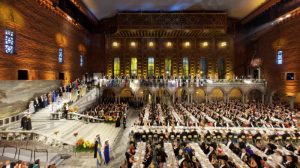 “诺贝尔晚宴也是一个乐章,如果你浮躁了,你就出去了。你要很冷静的随着那乐章进出。 你舞在其中,同时也是指挥者。既要激情,也要在喧噪里听到针的声音。否则,你什么也拍不到,看的只是热闹。
“诺贝尔晚宴也是一个乐章,如果你浮躁了,你就出去了。你要很冷静的随着那乐章进出。 你舞在其中,同时也是指挥者。既要激情,也要在喧噪里听到针的声音。否则,你什么也拍不到,看的只是热闹。
米勒斯花园也是一样。当你进入状态时,啊,很美,这时候,你要退一步,哪儿美,你这个美讲给别人听的时候,一定要退一步,这个美是哪儿美,是光线美,瑞典这个国家半年没见过太阳,突然见到太阳,是那种舒畅,那种挣扎,那么怎么表现它,有很多细节,就象那种婴儿肥绿,只有经历了半年黑暗的人才能体会到那种肥绿,那种美。美从哪儿来?你自己的感受。什么东西在这个地方最打动人?要找到那个地方。”李亚男一口气倒出了他的经验之谈,句句中的。
夕阳与倒影 李亚男拍摄
“构图是技术范畴的,关键在思想。你的想法,每个线索阐述成你的东西,需要长时间的训练。 对于真正的艺术家来说,最重要的是他自己在创作的时候,我在园子里面,我在诺贝尔晚宴的时候,你看到我紧张工作的时候,我在寻找我的目标的时候,那时才是我最欢愉的时候。”那些都是他默默无闻的,一丝不苟的工作身影。
“你必须跳出来。你怎么跳出来,你的优势在哪儿?一个是自身的文化修养,一个是你的文化积淀。去看宋人山水。去看所有你能看到的东西,都是养分。山岩壁画,到乔布斯。研究苏州园林结构,层次,看苏州园林,去拍市政厅,好像是风马牛不相及的东西,但这之间是修养”。这就是李亚男的思考。
 光,影,墨与雕塑艺术 李亚男拍摄
光,影,墨与雕塑艺术 李亚男拍摄  夜间的米勒斯花园 李亚男拍摄
夜间的米勒斯花园 李亚男拍摄
“将来一定有人比我拍得更好。再过10年,我拍的比我现在拍的更好。但是这就是艺术家的遗憾, 但现在,我要做到最好。”
身在异乡,很难跻身主流社会,是许多华人的感受。尤其从事艺术, 更是要经过非常艰难的挣扎。能站得住脚的,获得承认的,是不断的寻找,融合,锤炼,痛苦。但依然有坚持的结果。
记者:瑞典,于你很特别吗?你对未来如何期待?
李亚男:我在北京师范大学影视制作的时候看到伯格曼的电影,被震撼了,这是怎样的土地造就这样的电影哲学,学摄影的时候,当我捧起哈苏相机的时候,再次被那遥远的地方所吸引。哈苏那特殊的画幅,优雅,严肃,几近幽灵抠门般的快门声音…… 十几年前来到这里,一直用这种探究的心里去观察这里,在这里生活。弹丸之国,工业界无数的巨人,区区几百万人口啊!艺术界,甚至医学界。瑞典这个名字都是不能不让人仰视的。
李亚男1999年来瑞典,就读于瑞典北部著名的于默奥大学。
“我初来的时候,经历过所有那时代留学生的磨难,但各种经历都会给我许多的后来的灵感。潜移默化的一直影响着我, 所以我会珍惜我走的每一步,因为每一步,都会影响你的未来。甚至很多时候你会彷徨。” 李亚男说。
“关于未来,我不揣测未来,眼下需要考虑的事情很多。我目前有几个已经在做的项目,都是很重磅级的,需要一步一步的走。我很充实,但同时压力也非常大。因为每一个项目,都是一次挑战。要么,你是那百年中的某一个,要么,你是那唯一的一个。每一个唯一都是挣扎着站起来的。”李亚男最后说。
李亚男今年43岁,妻子卡特琳,他们有两个女儿。
纪念中国共产党成立95周年
北欧绿色邮报网社论:今天是中国共产党成立95周年纪念日。无论从党员人数上还是从成立的时间上,她都不愧为一个伟大的政党。更不用说她正在领导着13亿人口实现中国梦。
中国共产党是1921年7月1日在上海嘉兴的一个船上秘密成立了这样一个组织。紧接着1924年才成立了国民党。从此,国共两党分分合合,几经挣扎。
到1935年,中国共产党所剩无几。在这种情况下,以毛泽东为首的江西红军决定实行战略大转移,被迫长征。经过一年多的两万五千里长征,活下来的人都是精英。胜利到达陕北,各路人马会师,再次凝聚成一股中国历史上不可磨灭的力量。
毛泽东说:长征是宣传队,长征是播种机。星星之火,可以燎原。就是这些令人鼓舞的话语激励着一代又一代的中国人百折不挠,艰苦奋斗,用不言败。毛泽东的七律长征,一直是我在软弱,困难的时候让我重新崛起的激励歌。当我跑不动的时候,我就会想起长征,想起红军不怕远征难,万水千山只等闲。
中国共产党就是在这样艰苦的条件下决定坚持下去,建立自己的共和国,中国共产党领导自己的军队,依靠贫苦农民,既帮助他们,也依靠他们壮大了自己的队伍。中国军队的三大纪律八项注意也让中国的军队和老百姓形成了鱼水之情。
就是在这样的条件下,中国共产党领导的八路军,新四军,出生入死,最终也打败了国民党。
1949年在中国共产党领导下,成立中华人民共和国。是在中国共产党领导下,实现多党合作制,就是说在中国共产党领导下还有九个民主党派可以协商,可以共商国事。
新中国成立以后,在毛泽东同志的领导下,中国实现了新民主主义革命的胜利,那就是实现公私合营,完成社会主义改造。实现了国有制。
在农村实现了土地改革。但是,由于生产力落后,毛泽东又在综合大家意见后决定实行人民公社,实行生产队,实行社会主义大食堂,因为这样更能显示党和政府的关怀,如果实行分田到户,可能出现两极分化,又怕倒退回地主和贫农差距极大的境地。
因此,在农村经过斗地主分田地,经过人民公社和生产队,真正实现了人人平等。当然,男人和女人之间还是男人挣分多。
但总的来说,还是实现了平等,代价就是大家一起贫穷。如果能够一年360天都有粮食吃,那就是幸福生活。山秃秃的,因为柴草都被农民弄回家了。地也光光的。但人很朴实。
进入60年代,左的思想盛行。到70年代,中国提出了要实现四个现代化的目标。理想主义依然盛行。左右对抗,意识形态左右一切。
到70年代末,毛泽东主席去世后,邓小平出山,胡耀邦等领导人实现拨乱反正。农村实行联产承包提高农民的劳动积极性。80年代城市工人实行改革。
1987年提出沿着有中国特色的社会主义道路前进。正式竖起新的发展大旗。1992年以后,中国进入空前绝后的经济发展阶段。
2001年加入世贸,中国经济开始实现腾飞。
到2008年,中国经济成为引领世界经济的引擎。中国共产党从过去左的错误中转右,直接抓经济,保增长。左派被凉到一边了。右派大显身手。
中国在过去十年更是实现了经济总量位居世界第二的成绩。但挑战并存。
总结过去,展望未来,我认为中国共产党成功的秘诀在于严格要求自己,党员发挥了先锋模范作用。党员执行政策有力。不足之处在于,依然存在急躁冒进的思想。好大喜功的思想,依然有不实事求是,浮夸的情形。另外没有认真执行十大关系所考虑的综合平衡。
环境的代价是惨重的。但这似乎也是发展过程中难以避免的。
希望中国继续稳定和平发展。把工作重心从经济上分担给社会和环境一些。实现环境保护,社会平等,逐步实现人民安居乐业幸福安康,充满创新精神的社会。
瑞典著名华人摄影师李亚男的作品《米勒斯的家园与艺术》发布
北欧绿色邮报网报道(记者陈雪霏)--瑞典著名华人摄影师李亚男的摄影作品《米勒斯的家园与艺术》一书30日在米勒斯雕塑花园正式发布。
李亚男在新书发布会上。 陈雪霏拍摄
图中:中国驻瑞典使馆文化参赞浦正东,图右:乌妮塔.瓦斯。陈雪霏拍摄
李亚男摄影
米勒斯花园馆长乌妮塔.瓦斯首先介绍了新书发布的背景。她说,大约三年前,她见到李亚男,希望他能以不同于瑞典人的视角深度拍摄米勒斯花园。
她在接受北欧绿色邮报网专访时说,她看过李亚男以前的作品,他们想有个全新的角度,所以让李亚男来拍摄米勒斯雕塑园。
李亚男摄影
李亚男在2008年曾经以《未知之美 斯德哥尔摩市政厅》画册而在业内得到普遍承认。
瓦斯说他们此前并没有讨论该怎么样拍,而是告诉李亚男,你自己随便拍,什么时候都可以来,你有钥匙,你也可以住在这里。
李亚男摄影
就这样经过三年的努力,200多张照片收集在这本厚厚的书里。
李亚男介绍新书《米勒斯的家园与艺术》。陈雪霏拍摄
李亚男向来宾介绍了成书的过程,以及他自己的背景。李亚男是1999年来到瑞典的,此前是在北京师范大学学习学电影,他仰慕瑞典著名大导演伯格曼。但很快又喜欢上了平面的哈苏相机。
 他曾经当过一名很好的厨师,但是他更希望成为很高级的摄影师。因此,来到了瑞典。
他曾经当过一名很好的厨师,但是他更希望成为很高级的摄影师。因此,来到了瑞典。
李亚男先在北部的于默奥大学学习摄影,然后,在哥德堡边学习边工作一段时间。之后来到斯德哥尔摩,在市政厅工作。从那里他开始了摄影的历程。
图左:李凯,左二:中国银行斯德哥尔摩分行副行长郭欣,中:李亚男,右二:商务参赞韩晓东,右一:中国五矿驻瑞典代表处李鸿忠总经理。
出席新书发布的有中国驻瑞典使馆文化参赞浦正东,商务参赞韩晓东,中国银行驻斯德哥尔摩分行副行长郭昕和中国五矿驻斯德哥尔摩办事处总经理李鸿忠。
浦正东参赞看完画册评价说,“李亚男的作品给人一个全新的角度,是以一个中国人的视角来拍的,因此,与其它人的拍摄不同,给人一个全新的感受。这是华人的骄傲。”
瑞方出席新书发布的还有斯德哥尔摩音乐厅展览项目官员卡丽娜.斯万松,新书的编辑,排版,印刷等有关的所有人以及业界的评论家等30多人出席了新书发布会。
李亚男为读者签名。 陈雪霏拍摄
中国银行斯德哥尔摩分行副行长郭昕也说:“这是华人的骄傲。”
这是李亚男2008年他出版《未知之美 斯德哥尔摩市政厅》之后的又一重磅力作。
新书发布会 陈雪霏拍摄
小女孩的四季 李亚男摄影
人们仰望米勒斯的作品和李亚男的摄影 陈雪霏拍摄
李亚男摄影
李亚男的作品为何与众不同?请继续阅读独家专访:
瑞典著名华人摄影师李亚男的作品《米勒斯花园的四季》在诺奖颁奖地展出
北欧绿色邮报网报道(记者陈雪霏)--瑞典著名华人摄影师李亚男的摄影作品《米勒斯花园的四季》6月28日开始在著名的诺贝尔颁奖地斯德哥尔摩音乐厅展出。
图左:卡丽娜.斯万松,中:李亚男,右:乌妮塔.瓦斯。陈雪霏拍摄
当天上午11点,门外阳光明媚,晴空万里,一进音乐厅的大门,大提琴演奏贝多芬的乐章。伴随着这优美的音乐,人们进入了米勒斯雕塑图片的殿堂。
上了台阶,呈现在人们眼前的就是mini米勒斯雕塑花园。那一盆盆青翠的看青,让人感觉彷佛有潺潺的流水喷泉,在室内,却感觉进到了米勒斯的世界。而这些正得益于李亚男的优秀作品。
12点整,人们聚在小花园前。项目官员卡丽娜.斯万松(Karina.Svensson)首先介绍了展览的情况。
陈雪霏拍摄
音乐厅前的雕塑群。 李亚男摄影
她说,今年是音乐厅前面的米勒斯的群雕塑在那里矗立80周年纪念日。音乐厅除了前面的著名群雕塑,其他地方还有四件米勒斯的雕塑作品。为了纪念米勒斯的雕塑,音乐厅特意找到米勒斯花园,然后,找到了李亚男。所以,这是他们合作的结果。
在这里人们可以一边听贝多芬的乐章,一边欣赏李亚男眼中的雕塑作品。
李亚男摄影
“李亚男的作品与众不同,给人印象深刻。有了这些照片,可以更好地展现米勒斯的作品。尤其是他能把东方的水墨画艺术与米勒斯的雕塑艺术合为一体。” 斯万松评价说。
米勒斯博物馆馆长乌妮塔.瓦斯出席开幕式。陈雪霏拍摄
米勒斯花园博物馆馆长乌妮塔.瓦斯说,三年前,她见到李亚男,觉得他可以以一个中国人的视角来拍摄米勒斯雕塑花园。
李亚男摄影
“我们有过很多人拍摄雕塑花园了,我们不想要同样的视角。我们觉得李亚男可以给我们一个全新的角度。在这个过程中,李亚男也付出了很多汗水。”瓦斯说。
李亚男说,他感谢米勒斯馆长对他的信任。接到这个任务,感觉这是一项伟大的任务,也是艰巨的任务。他准备了三年,终于以一个东西方碰撞的视角,挖掘了米勒斯的思想深度,与其碰撞。
在过去的1000多天里,李亚男几乎每个季节,每天的每个时间段和每种天气状况都经历过了。经过他的拍摄,米勒斯花园活了,雕塑活了!
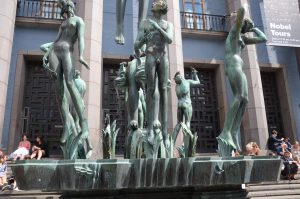 该展览将一直持续到8月20日。每天11点开始17点结束。14:00还有导游讲解。预计7万人将参观展览。
该展览将一直持续到8月20日。每天11点开始17点结束。14:00还有导游讲解。预计7万人将参观展览。
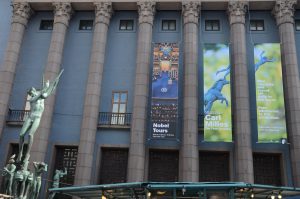 这是100多年来首次有华人摄影师的作品参加音乐厅的夏展。这是华人的骄傲。
这是100多年来首次有华人摄影师的作品参加音乐厅的夏展。这是华人的骄傲。
 6月30日,李亚男摄影的新书《米勒斯的家园与艺术》发布会将在米勒斯花园举行。
6月30日,李亚男摄影的新书《米勒斯的家园与艺术》发布会将在米勒斯花园举行。
为什么李亚男的作品与众不同?敬请关注北欧绿色邮报网独家专访:
一个展览
一本书
一个东西方碰撞的视角
独家专访瑞典著名华人摄影师李亚男。
Sweden becomes a member of the UN Security Council
STOCKHOLM, June 29(Greenpost)–Sweden has been elected to the United Nations Security Council 2017-2018, announced Minister for Foreign Affairs Margot Wallström on Tuesday.
“Six months ago we were considered to be out of the running. Today we have a seat on the Security Council. This is a great victory for Swedish foreign policy and Swedish diplomacy,” said Wallström in a statement.
“For a government that stands for solidarity and cooperation, a seat on the Security Council is an acknowledgement that a global policy for sustainable peace and development pays off. For the United Nations, this means that one of its largest donors is taking its engagement and ideas, along with its demands for reform and change, into the organisation’s innermost room,” said the statement.
“During our two-year term, we will take our share of responsibility for international peace and security that membership of the Security Council entails. On 1 January 2017, when we take our seat at the table that has become a symbol of world affairs, we will do so as President, at the same time as the next Secretary-General of the United Nations takes office,” said Wallström.
Sweden’s candidacy was based on issues and on a belief in dialogue and diplomacy as tools. Deeper contacts with many countries around the world have given us a better understanding of how today’s challenges are perceived and experienced, but also a basis for advancing Sweden’s vision of democracy and human rights, gender equality and development. This is also how Sweden will work as a member:” we will listen to those concerned, defend those who need to be defended and stand up for those we believe in”.
Security, development and gender equality are interlinked. Poor countries run a much greater risk of being affected by conflict. Sweden will work to make the Security Council better at acting before conflicts erupt.
“We will work to make the Security Council see the nexus between security, development, climate and gender equality. We will work to highlight the perspective of women in conflict situations. Half of the world’s population cannot be excluded if we want to achieve sustainable peace,” said Wallström in the statement.
Wallström said the UN must become more open – even more open. “We want to work for greater transparency and openness in the Security Council. We want to talk with countries, rather than about countries. We want to strengthen dialogue with civil society, women’s organisations and other peace actors. This is how to build a peaceful world.”
She said Sweden will deal with issues on the Security Council agenda on the basis of Swedish values. “The last time we had a seat on the Security Council, we were always the ones to emphasise international law and human rights. And that’s how it will be this time too.”
The situation in Sweden’s neighbourhood and the fact that our European security order is being challenged demonstrate the importance of respect for international rules and principles. “This perspective will be central during our two-year term on the Security Council,”.
Sweden will be a member of the UN security Council from January 1, 2017.
“We will be doing so at a time when, all around the world, uncertainty and insecurity are taking a toll on people’s lives, and the need to work together to build sustainable peace and resilient communities has never been clearer. We will do so because we are convinced that as a small and open country dependent on the rest of the world, it is in our interest to contribute to and defend the international order that has at its core the United Nations and the Security Council. And we will do so because we believe we can make a difference – through our policies, our values and our engagement,” the statement said.
